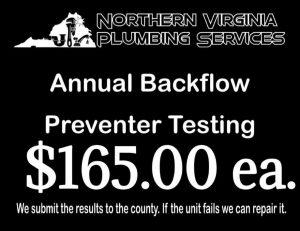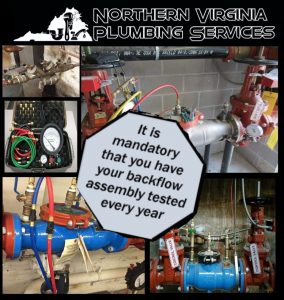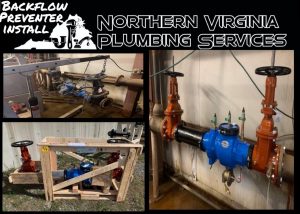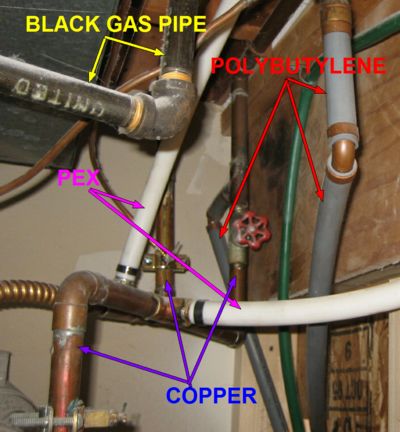Northern Virginia Plumbing Services Payment Policy is as follows:
****** FINANCING INFORMATION *******
Financing is available for any job over $500 through Wisetack. Please visit their website https://www.wisetack.com for further details.

Do you rely on a sump pump to keep your basement dry?
Do you feel anxious when the power goes out during a storm?
Residential Sump Pumps operate on 120 V and are useless without power. Flooding can occur quickly with no means to pump the water out of the drain.
Backup sump pumps are installed along with the primary pump and continue to operate in the event of power loss or in the event a primary pump fails. The backup pump is mounted above the float for the main sump pump and turns on when the water exceeds this height. During blackouts or if the primary pump fails, the backup sump pump turns on.
There are two main types of backup sump pumps to prevent flooding and keep basements dry should power fail or the primary sump pump fails:
Battery–powered sump pumps are the most popular backup sump pump. They are powered by a deep cycle marine battery that maintains a charge through a trickle charger. This type of pump is frequently available in an assembly that includes the primary pump and are connected to the same drain line. Installation is easy and can be done by most homeowners. Battery backups can operate continuously for 4 to 5 hours or intermittently for as long as a day.
Water-powered backup sump pumps are an alternative to battery-powered pumps. As opposed to 120 V or battery backup pumps, water-powered pumps do not require an external electric power source. Instead, they are powered by the municipal water supply. Since the water is constantly flowing, the pump will continue to operate even during extended power outages.
As with battery-powered backup pumps, the water-powered pump is mounted above the float for the main pump and contains its own float.
Water-powered backup pumps operate on the principle of the Venturi effect. When the float for the backup pump is activated, it opens a valve connected to the municipal water supply. The municipal water flows through a constricted area in the pump ejector that increases the water velocity and reduces the pressure. This results in a suction that draws the water from the sump through a drain line and discharges it outside the house. Two gallons of water can be pumped for every gallon of municipal water. They are more expensive and complicated to install than battery-powered pumps, but they can be worth the effort and money in areas prone to flooding or power outages.

Water that comes into a building from the main water supply should only flow in one direction. Backflow happens when water pressure changes or atmospheric pressure causes water to flow back into the main water supply. When this happens contaminants can backflow into the counties clean water supply. This is why backflow preventer valves are required in all commercial buildings and in residential situations with fire and lawn irrigation.
A backflow preventer is a device designed to prevent water from flowing back into the clean water supply. The valve does not allow water to backflow even if there are water pressure changes in the plumbing. Because of this, backflow preventer systems are required to be inspected and tested annually by plumbers who are certified to test these types of systems.
There are a few different types of backflow preventer valves that are used in commercial buildings/residential homes. Buildings/homes can have one or more backflow systems.
All backflow valves need to be inspected and tested ANNUALLY. Typically, businesses or property owners are notified by the county when their inspection is due. It is up to the business to schedule the inspection with a certified plumber.
N.V.P.S has certified plumbers who can perform these inspections for your backflow systems so call us today:


Polybutylene is a plastic resin that was used extensively in the manufacture of water supply piping from 1978 until 1995. Due to the low cost of the material and ease of installation, polybutylene piping systems were viewed as “the pipe of the future” and were used as a substitute for traditional copper piping. It is most commonly found in Northern Virginia areas such as Alexandria, Annandale, Dale City, Dumfries, Herndon, Lake Ridge, Manassas, Montclair, Oakton, and Springfield.
Exterior – Polybutylene underground water mains are usually blue, but may be gray or black (do not confuse black poly with polyethelene pipe). It is usually 1/2″ or 1″ in diameter, and it may be found entering your home through the basement wall or floor, concrete slab or coming up through your crawlspace. Frequently it enters the home near the water heater. Your main shutoff valve is attached to the end of the water main. Also check the water meter that is located near the city water main. It is wise to check at both ends of the pipe because we have found cases where copper pipe enters the home, and poly pipe is at the water meter. Obviously, both pipes were used and connected somewhere underground.
Interior – Polybutylene used inside your home can be found near the water heater, running across the ceiling in unfinished basements, and coming out of the walls to feed sinks and toilets. Warning: In some regions of the country plumbers used copper “stub outs” where the pipe exits a wall to feed a fixture, so seeing copper here does not mean that you do not have poly.





1. We ask that you stop using either the shower or the toilet in the bathroom above the leak location.
2. If the bathrooms are both on top of the leak, use only one bathroom for a few days then switch to the other.
3. Check daily for leaks.
4. If after a few days the location of the leak cannot be identified, we will come out and perform a Minor leak search using both moisture and thermal imaging, combined with precise fixture troubleshooting at tie-in and connections.
5. The next step is a major leak search involving drop cloths, ladder, and dry wall cutting. Once the problem is located, we can explain your options and provide pricing for that specific job.
Northern Virginia Plumbing Services is happy to offer our Customers a free written estimate when possible. The value of a comprehensive estimate when comparing contractors is priceless.
To qualify for a free estimate, customers must:
A) Be the property owner (NVPS needs to deal directly with the owner),
B) Reside within the Northern Virginia service area, AND
C) Plan to have all work performed during regular business hours.
The following conditions apply:
Northern Virginia Plumbing Services is committed to safeguarding your personal information, in all aspects of the work we do for you. We keep all your information confidential and private. No information will ever be given to anyone, ie realtors, neighbors, etc.
Your email address/phone number is used to:
N.V.P.S. does not sell, trade, or rent your private information to marketing or research companies. We value and respect your privacy.
Our employees understand the importance of safeguarding your information and while in your home, any information about your residence, your property, or the work being done is kept purely confidential. We do not discuss your home or business, property, improvements, or work done in or around your property with anyone.
Northern Virginia Plumbing Services knows your time and money are valuable. By providing our customers with fair and competitive prices every day, there is no need for special offers, seasonal specials, or sales promotions.
We do not charge:
We recognize those that have carried an extra burden for society deserve a hand-up, not a hand-out so we offer the following (please mention your discount when contacting N.V.P.S.):
Northern Virginia Plumbing Services will guarantee the following, (with the exceptions listed below):
N.V.P.S. cannot offer any warranty for Material that is Owner Furnished. There is No implied Warranty or Warranty of Merchantability on any Material that is Owner Furnished. Acquisition of repair parts and labor costs after 30 days of work completion is the responsibility of the Customer providing Material.
